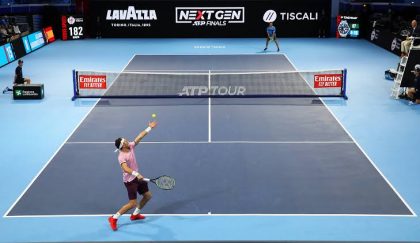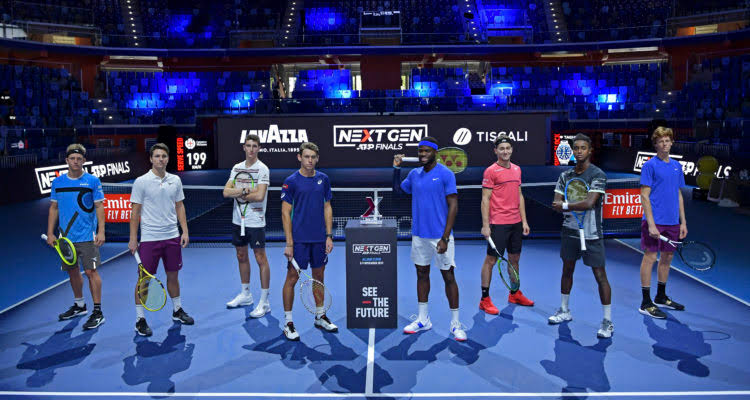It’s a well-known fact that every single thing goes into renovation and re-shaping as we move on, sports are, certainly, included in this category that undergoes usually, from time to time, new adjustments and modifications that are probably attributed to two main reasons; to cope with the contemporary trend, particularly, among young people and other commercial aspects like promoting it to a broader population of fans. Tennis is one of a few sports that has retained most of its rules and traditions until the moment, however, introducing some little changes in the game could serve the sport better, make it more interesting for people got already bored of it, even more appealing for new audience, and most importantly more optimum and safer for the players.
We will get through some of the new technological and technical innovations that have been introduced into the Next Generation ATP Finals over the three editions of the tournament and expose its pros and cons.

The format of the tournament, since its emerging in 2017, has been quite different with the objective of attracting more fans by making matches quicker and have more exciting moments in less amount of time.
The most fundamental part of the new format has been the number of games per set, which became four games a set instead of 6 with a Tie-Break at 3-All, and No-Ad scoring. The shorter set has been compensated for with the matches being best-of-five sets so that a player needs to win 12 games to win a match. The introduction of such a new format has obviously increased the intensity of the matches by speeding up the pace of every rally, so that after every changeover you will definitely not witness more than 14 points thanks to the No-Ad scoring role, which means also more break points.
The No-Ad scoring role, similar to that in doubles competition in the standards ATP tour, means that when it’s tied at deuce (40-All), the next point is considered the deciding point and regarding serving either in the deuce or advantage courts, in 2018 edition it was the receiver’s choice, while in 2019 it’s up to the server player.
I think that these modifications on the traditional format have brought much dynamics and speed, as you can see that everything is pretty quick that needs the players to exert little physical efforts on each point which eventually helps them comply much easier to the shot clock and most probably that would impress a lots of fans amongst young ones, and would be appreciated as well by most people having a real busy schedule.
However, players have to adapt to this new format in terms of mental alertness and tactics, because everything is going very fast and if one player lost his concentration for a moment or two on his service game, with the No-Ad scoring rule, that could cost him the set which would ruin his whole match even with considering that it’s a best-of-five sets match.
The innovations, at the Next Generation ATP Finals, haven’t been only technical but also included new cutting-edge technological services that would not only help ease the calls on points but also give the players and their chosen coaches reliable data and physical measures about their own performance and workload after each match that would assist them on evaluating their plans and training strategies.

The usage of the very innovative Live Electronic Line Calling system has so many remarkable merits, as it really helps eliminating human’s errors, yet not absolutely eliminating errors as sometimes the machine doesn’t work in very rare cases, that’s why in close callings players have the right to watch a video review to get assured of the call. In addition, this contributes a lot to shorten the average time taken between points as the calls are usually clear and need no more evaluation from the umpire or the players. Another major advantage for such system installation is that now players don’t have to challenge calls they are having doubts over, for instance a player could’ve used all their challenges and they can no longer challenge the call despite having the call wrong, that would never be encountered with this innovative system.
The third edition of the Next Generation ATP Finals also features an unprecedented technology available on ATP, in which players are allowed to use wearable devices that would measure velocity and direction, acceleration and force, rotation, body orientation, and will quantify internal load (through heart rate). The data collected would be available after matches for the players and their coaches for further assessing the key elements of their game.
All these previous innovations and rule modifications cannot be seen, generally, to be compromising the core of the traditions of tennis, however, there is a one rule introduced at the Next Gen ATP Finals that shows a lot of controversy over if it’s affecting the core of the game or not, it’s the In-Match Player Coaching via head-sets. According to this rule, a player can communicate with his coach during a match at certain points, similar to what’s happening in the WTA, however the coaches aren’t permitted to come on court.

Some top players have had their say about that topic. While some backed the very new feature, others thought it doesn’t belong to the world of tennis.
“I’m not all for it, I find it kind of cool that in tennis, you know, you’re sort of on your own out there. Not everybody has the same amount of resources for coaching, as well. So I’m not sure if it’s that beneficial.” Argued 20-time Grand Slam Champion Roger Federer.

Federer’s long term rival Novak Djokovic had another thought about the In-Match Coaching, thinking that tennis should be like most of the other sports in this aspect of the game.
“When the WTA introduced on-court coaching, many ATP players were not really positive about it. I thought it was a good move for the sport. I mean, we’re probably one of the only, maybe [the] only global sport that doesn’t use coaching during the play. Even golf, individual sport, you have caddies that you communicate with throughout the entire course.” Said Djokovic.
One way of thinking is that tennis is based on playing individually in the first place, of course, players do put strategies and tactics with their coaching teams but when they get to the court, it’s all theirs, not only physically but also mentally, that’s why some players hire psychotherapist. On the other hand, some players might have some mental weaknesses and such an opportunity could deal with this problem during the match, and at the same time the other player would be offered the same opportunity so it’s fair after all.
I think people should keep watching closely this controversial very new rule being introduced to the world of tennis at the editions of the Next Gen ATP Finals and its effect on the players, then they can conclude whether it would affect the game in a positive or negative manner.
To conclude, every single sport has to keep up to date with the advancements taking place and the common tends, yet never to change its roots that it’s already been built upon. With most of the innovations that have been introduced to the Next Gen tournament, I think there is a great combination between cutting-edge technology represented on facilitate officiating and giving useful information for the players about their game, and optimizing some rules that wouldn’t necessarily compromise the origin of tennis.






